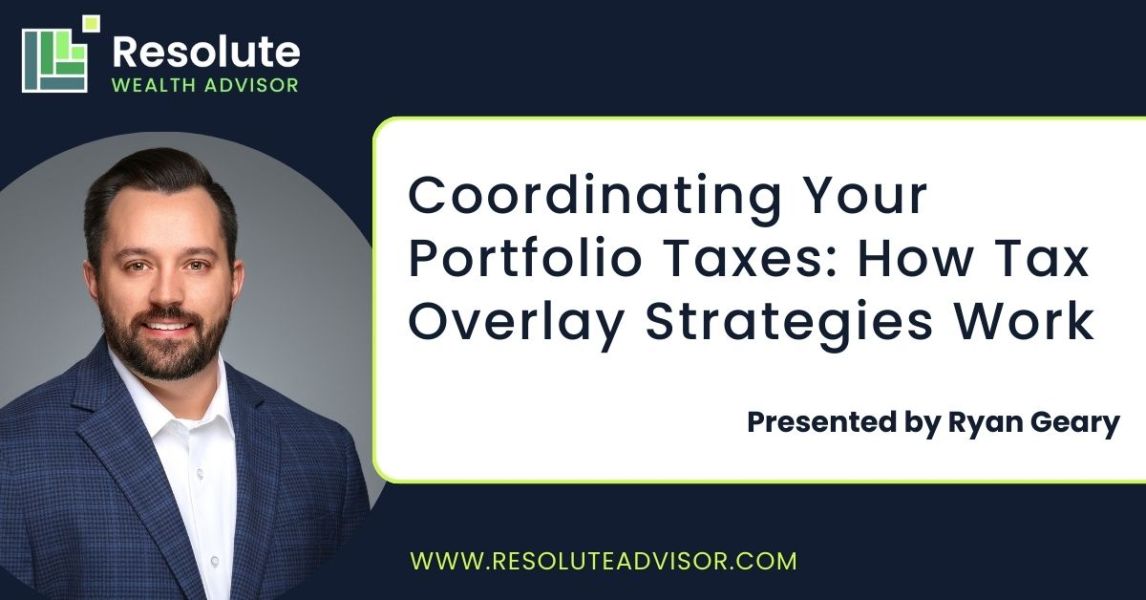How Tax Overlay Strategies Work

by Ryan Geary
When people think about investment performance, the focus is usually on market returns.
But one factor that often gets overlooked — and can quietly reduce your wealth — is taxes.
But one factor that often gets overlooked — and can quietly reduce your wealth — is taxes.
Every time a portfolio manager buys or sells investments, it can create taxable events.
Short–term gains in particular are taxed at higher rates. And if you have multiple managers
working independently, gains and losses don’t always offset each other, which can
increase your tax bill unnecessarily.
That’s where a tax overlay strategy can help.
What Is Tax Overlay?
Think of tax overlay as the conductor of your investment portfolio. While each manager still
contributes their expertise, the overlay service coordinates across managers to reduce
unnecessary tax drag.
contributes their expertise, the overlay service coordinates across managers to reduce
unnecessary tax drag.
It’s important to note: tax overlay applies to after–tax brokerage accounts only — not
IRAs or other qualified retirement accounts, which already benefit from tax deferral.
Some of the key benefits include:
• Gain/Loss Matching: Offsetting gains with losses throughout the year whenever
possible.
• Deferring Gains: If no losses are available, delaying certain trades until investments
qualify for long–term capital gains rates.
• Tax Budgets: Allowing clients to set guidelines for how much in gains they’re
comfortable realizing in a given year.
A Quick Example of Tax Drag
Let’s say an investor has a $500,000 taxable brokerage account. Over the course of the
year:
year:
• Manager A sells several positions, creating $20,000 in short–term gains (taxed at
the investor’s ordinary income rate, say 32%).
• Manager B independently realizes $15,000 in long–term gains (taxed at 15%).
Because the trades weren’t coordinated, the investor ends up owing about:
• $6,400 in taxes on the short–term gains ($20,000 × 32%).
• $2,250 in taxes on the long–term gains ($15,000 × 15%).
• Total tax bill: $8,650.
Now imagine if Manager A’s short–term gains had been offset with other losses in the
portfolio, or if some of those trades had been deferred until they qualified for long–term
rates. The tax bill could have been significantly lower, keeping more money invested and
compounding for the future.
portfolio, or if some of those trades had been deferred until they qualified for long–term
rates. The tax bill could have been significantly lower, keeping more money invested and
compounding for the future.
That’s the essence of tax drag — when uncoordinated decisions across a portfolio create a
higher tax bill than necessary. A tax overlay strategy seeks to minimize that drag by looking
across managers and accounts holistically.
The Long–Term Impact of Tax Drag
Taxes don’t just reduce returns in a single year — they can compound against you over
time. Even small differences in annual tax efficiency can add up.
time. Even small differences in annual tax efficiency can add up.
For example, an investor who consistently realizes more short–term gains will generally pay
more in taxes than one who coordinates across managers to limit unnecessary taxable
events. Over time, that difference in tax efficiency may allow more of one investor’s money
to remain invested and working toward long–term goals.
Every investor’s experience will differ, depending on tax rates, timing of trades, and market
performance. The key point is that reducing tax drag can make a meaningful difference
over time, even if the annual differences seem small.
The Goal: Better After–Tax Results
The objective of tax overlay isn’t to eliminate taxes altogether — that’s not possible.
Instead, it’s about being more intentional and coordinated, so more of your money stays
invested and working toward your long–term goals.
Instead, it’s about being more intentional and coordinated, so more of your money stays
invested and working toward your long–term goals.
Is It Right for You?
Tax overlay strategies can add another layer of sophistication to your investment plan, but
they’re not one–size–fits–all. If you’d like to explore whether this approach makes sense for
your financial situation, let’s connect.
they’re not one–size–fits–all. If you’d like to explore whether this approach makes sense for
your financial situation, let’s connect.
1. Tax Overlay Services may involve additional fees. Results vary depending on
individual circumstances. There are no assurance tax overlay strategies will improve
returns.
2. Tax Overlay Services apply to after–tax brokerage accounts only, not IRAs or
retirement accounts.
3. Clients should consult a qualified tax advisor regarding their specific tax situation.
4. Past performance is not a guarantee of future results. All investments involve risk,
including the possible loss of principal.
5. Any discussion of long–term tax impact is provided for illustrative and educational
purposes only, and does not represent actual or hypothetical client performance.
3. Clients should consult a qualified tax advisor regarding their specific tax situation.
4. Past performance is not a guarantee of future results. All investments involve risk,
including the possible loss of principal.
5. Any discussion of long–term tax impact is provided for illustrative and educational
purposes only, and does not represent actual or hypothetical client performance.
